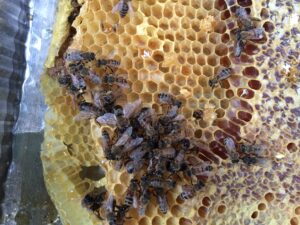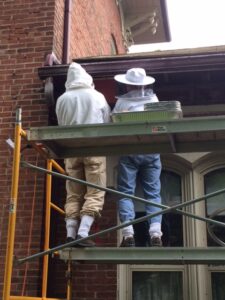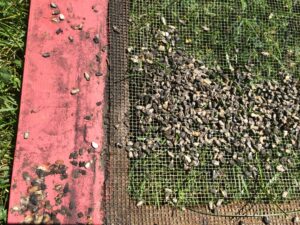Here’s some things to think about for your apiary about this time of year–for colonies in climates similar to ours … in my opinion of course. Beekeeping practices vary.

Speaking of drones, we recently removed several from an in-roof thriving colony, along with their many sisters. This shot shows some of the comb we pulled with some of the huge drones. They were very content to go for a ride to a new hive.
1) Wish a Happy Father’s Day to any friendly drones you see. Hopefully those will be the ones “lucky” enough to become fathers by mating and sharing their happy genetics. I say “lucky” because the mating act does kill them … which I think beats dying in the fall when their sisters kick them out in the cold, but what do I know. While I tend to drone, I’m not a drone.

Here are a couple of drones, my husband Marshall, and Steve, owner of the home from which we’re removing bees. He now finds honeybees very fascinating and jumped in to help us.
2) Deal with this humidity: There are several parts to this …
Screened bottom boards? If so, pull those slider boards (also called debris boards.) Mold / fungal infections are very common right now because it seemingly rains all the time!
Entrance reducers still in? Assuming you have enough bees to cover most of the frames in your first box, and of course assuming summer is here—you can open up the entrance more or perhaps fully—depend upon the strength of the colony.
Do some weeding: the rain has made everything grow. Pull or shorten any plants preventing easy flight in and out, as well as any plants that may be impeding air flow up under the hive.
Feeders: If you still have a feeder in or on, you can probably remove it. Most colonies have sufficient numbers and stores by now to survive a bit of a dearth—but don’t pack it too far away. We often get summer dry spells (can’t really imagine that now, but …) where nectar slows down and having water readily available via a feeder is helpful.

This is one of our colonies with Chalkbrood–notice the white and some darker) pieces of “chalk” that theyve brought out–dead babies. The large upper entrance of the top box should help by adding circulation. The colony is now large enough to need two boxes.
Do you have an upper entrance on your colony? Not only does that help with air flow, but as the colony grows, it shortens the trip for bees to get to the upper boxes (assuming Lang equipment of course.) Anything I can do to help my girls make honey more efficiently. I’ve certainly become more efficient at eating it.
3) Watch for Chalkbrood (and other bee diseases). A disease occurring more frequently is our parts is Chalkbrood. Dampness promotes it (did you notice it seems to rain all the time?) It is fairly easy to identify because it looks like little pieces of chalk. You’ll likely see them on the landing board as worker bees clean out infected bees-to-be. You may also notice it in the bottom of the hive if you get that far on an inspection, as well as in frames – as white cells of dead brood.
We have it in a couple of our colonies—as shown in the photo. We moved the frames of the worse-infected colony to a new, clean, mold-free box and have vinegar-rinsed the boxes used by that infected colony. We’ll let it dry out well … and hopefully spend some time in the sun. Y’know, if we ever see the sun again.

Yuck- Chalkbrood disease causes dead babies … and this colony couldn’t keep up with carrying them out. The “pieces of chalk” are in various stages of decomposition.
If you have Chalkbrood, be sure to clean your gloves and hive tool after you leave that colony. There’s a great document describing it at http://edis.ifas.ufl.edu/aa138.
Luckily, Chalkbrood doesn’t typically kill the colony, although it takes a toll by both killing developing bees and adding work to the bees cleaning it up.
4) Deal with Varroa mites. Varroa mites. Damn them!! Most first year beekeepers think they don’t have to worry about them. Wrong. Dead wrong, and by dead wrong, I mean, well, let’s talk about death.
Every colony gets them, great colonies keep them under control. Most colonies though end up losing the battle within a year or two and dying.
Having lost WAY too many bees, I’ve now declared war on them. We’re monitoring all our colonies to test the levels, and for the first time ever, I’m treating chemically (yes Chuck, you read that right–I am) if there is an issue. One of my bee mentors, Dr. Meghan Milbrath, likens Varroa to heartworm in dogs. A responsible owner checks for it, and if it is detected, treats so the dog doesn’t die. If you have a colony not keeping them under control, I (and she) now recommend treating them to stop their slow (or quick) march to death.
Treatment can take many forms, from powdered sugar to drone foundation to screened bottom boards to a spectrum of chemical products. I’ll discuss these more in a future blog. Meanwhile, monitor your hive to see if you have a problem … yet. I love the monitoring method poster found here: http://www.beelab.umn.edu/prod/groups/cfans/@pub/@cfans/@bees/documents/asset/cfans_asset_381124.pdf
I’ll post some pics of us doing it soon, but please do some reading and begin monitoring. It is part of being a responsible bee owner.
5) Contact me – with any questions, issues or cool happenings (swarms!) I’ve learned so much working with folks trying to figure things out, thanks!
